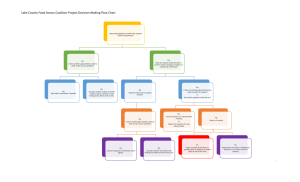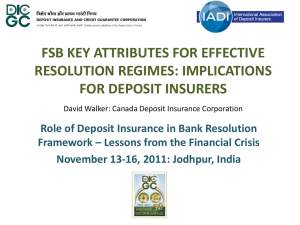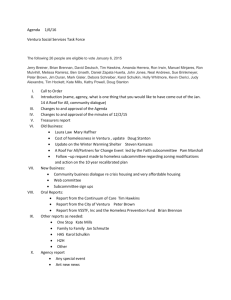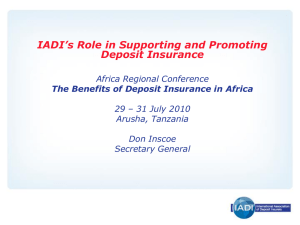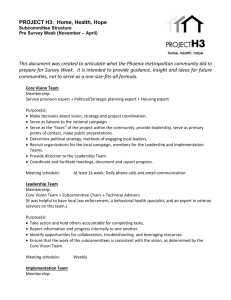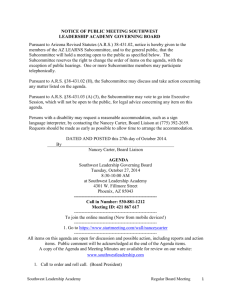Research Plan on - International Association of Deposit Insurers
advertisement
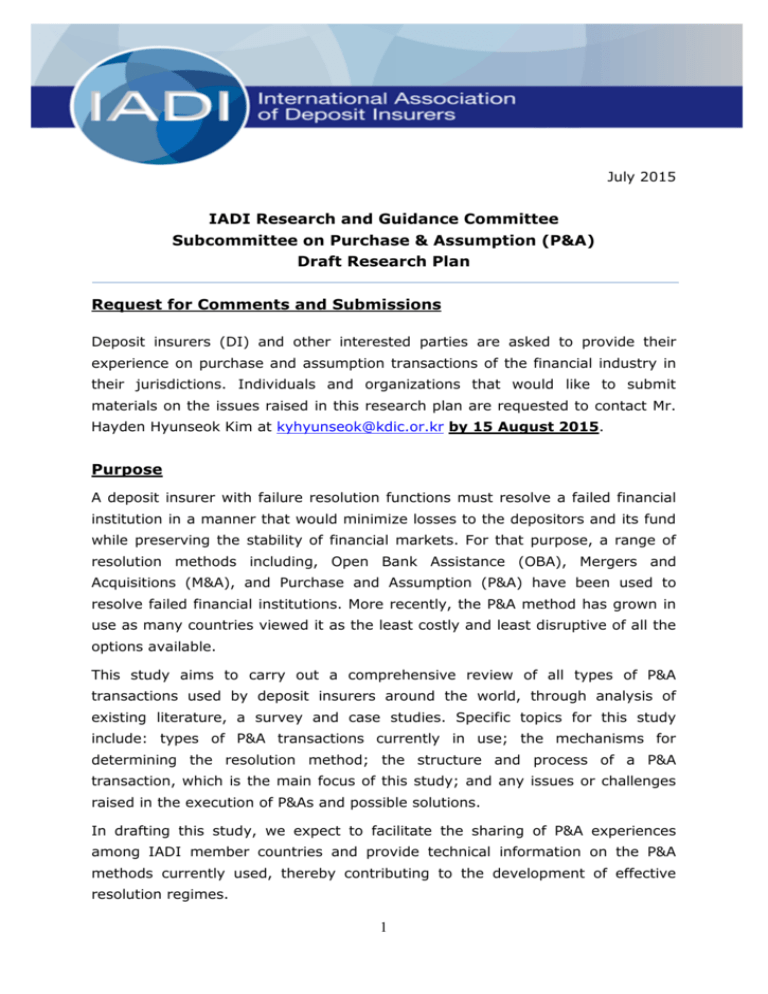
July 2015 IADI Research and Guidance Committee Subcommittee on Purchase & Assumption (P&A) Draft Research Plan Request for Comments and Submissions Deposit insurers (DI) and other interested parties are asked to provide their experience on purchase and assumption transactions of the financial industry in their jurisdictions. Individuals and organizations that would like to submit materials on the issues raised in this research plan are requested to contact Mr. Hayden Hyunseok Kim at kyhyunseok@kdic.or.kr by 15 August 2015. Purpose A deposit insurer with failure resolution functions must resolve a failed financial institution in a manner that would minimize losses to the depositors and its fund while preserving the stability of financial markets. For that purpose, a range of resolution methods including, Open Bank Assistance (OBA), Mergers and Acquisitions (M&A), and Purchase and Assumption (P&A) have been used to resolve failed financial institutions. More recently, the P&A method has grown in use as many countries viewed it as the least costly and least disruptive of all the options available. This study aims to carry out a comprehensive review of all types of P&A transactions used by deposit insurers around the world, through analysis of existing literature, a survey and case studies. Specific topics for this study include: types of P&A transactions currently in use; the mechanisms for determining the resolution method; the structure and process of a P&A transaction, which is the main focus of this study; and any issues or challenges raised in the execution of P&As and possible solutions. In drafting this study, we expect to facilitate the sharing of P&A experiences among IADI member countries and provide technical information on the P&A methods currently used, thereby contributing to the development of effective resolution regimes. 1 Background The recent global financial crisis brought failure resolution to the center stage of worldwide discussions. This is because the disorderly collapses of many financial institutions, including Lehman Brothers, during the crisis did not only cause great losses to individual financial consumers but also wreaked social and economic havoc by disrupting the financial system and requiring a massive injection of public funds to mitigate systemic risk. In response, governments around the world and international organizations, in particular the Financial Stability Board (FSB), began to rethink how to address challenges in developing orderly and effective resolution regimes. As a result, in the United States, the Dodd-Frank Act introduced the Orderly Liquidation Authority while in the United Kingdom, a Special Resolution Regime was established under the Banking Act of 2009. Also, the FSB published the Key Attributes of Effective Resolution Regimes for Financial Institutions, setting out essential features that should be part of any resolution regime. Meanwhile, to deal with the effects of the global financial crisis, deposit insurers in many countries took action to prevent bank runs and maintain financial stability such as, increasing the scope or limit of coverage and shortening the payout period. Importantly, many of them were given a bigger mandate from a simple pay box to a system with extensive responsibilities including certain resolution functions. Furthermore, the IADI, in cooperation with the Basel Committee on Banking Supervision, developed the Core Principles for Effective Deposit Insurance Systems (the Core Principles) in 2009, later to be revised and re-published in November 20141. The Core Principles were included in the FSB’s Compendium of 12 Key Standards for Sound Financial Systems in 20112 and are used by the International Monetary Fund and the World Bank in the context of the Financial Sector Assessment Program. The Core Principles encourage deposit insurers to have an effective resolution regime that ensures prompt and accurate reimbursements and minimization of resolution costs and market impact, which is seen as a useful guideline for designing a deposit insurance system with resolution functions. 1 Following the global financial crisis and as a result of work by a Joint Working Group consisting of representatives from the Basel Committee on Banking Supervision (BCBS), European Commission (EC), European Forum of Deposit Insurers (EFDI), FSB, IMF, World Bank and IADI. 2 Later to be replaced by the Revised Core Principles 2 There have been a range of resolution options that can be largely grouped into two categories: open and non-open 3 . The non-open methods include: P&A, bridge bank, and bankruptcy/liquidation. Among them, the P&A method is considered to have advantages over other alternatives because it is less disruptive to the communities than bankruptcy/liquidation and helps reduce the risk of the acquirer falling into insolvency as the acquirer usually assumes only good assets and liabilities from the failed financial institution. Further, it has been shown that P&A is a more efficient option for resolving small and medium sized firms, which have a greater chance of failure and have actually failed more often than large ones. For these reasons, there is a growing demand for research on P&A providing technical information for practical use. Therefore, the P&A Subcommittee intends to study current practices, look at different country examples, examine the processes and problems related to P&A and provide technical and practical information on the P&A resolution method. Issues to be Addressed 1. Overview of Resolution Regimes around the World A. Legal Framework Governing laws and regulations for, and structure of resolution regimes, roles of Resolution Authority(ies) and their relationships Any legal provisions specific for P&A transactions B. Resolution Methods and Procedures Resolution options available and the mechanisms for determining the resolution method, and Overview of resolution procedures (focusing on P&A) C. Past Experiences of Failure Resolution Past experiences of resolution of failed financial institutions including resolution methods used, resolution costs, outcome, and other issues 3 The difference between open and non-open is while open occurs when a distressed financial institution remains open, non-open options close it in the process of resolution. Open includes the option of open bank assistance (OBA). 3 2. Theory and Practice of P&A A. Theory of P&A Background for the adoption of the P&A method including main characteristics of the financial market, advantages and disadvantages of P&A vis-a-vis other resolution options, and review of theoretical research on P&A B. Practice of P&A Types, structures and procedures of P&A transactions, timeframes of the P&A process, and issues to be considered in different steps of the P&A process 3. Key Issues Related to P&A Issues to be examined when conducting P&A such as, the risk of a bank run the basis for transferring contracts to another (or a bridge) bank due diligence issues valuation method used types of assets and liabilities transferred legal priority in the transfer of assets and liabilities special incentives for acquiring entities estimation of the cost to the deposit insurer potential violation of property rights dispute types and other constraints effects of P&A to criminal/fraud cases initiated by the regulator/resolution authority/deposit insurer consent of the creditors on the valuation hair-cut and transfer of assets amendment of the original contracts in the process of transferring contracts 4. Summary and Conclusion Technical and practical information for effective P&A in the future will 4 be provided based on a comprehensive analysis of country cases, theoretical and practical aspects of P&A and other issues of importance. Methodology A. Literature Reviews The work plan will be modified as necessary, followed by a review of literature and case studies. B. Survey A survey will be conducted to gather data and information in order to address issues identified by the P&A Subcommittee with the Data and Survey Committee of the IADI. C. Preparation for the Research Paper A draft technical paper will be prepared by Subcommittee members. After circulating the completed draft to IADI Members and concerned external parties, reviews and comments received will be incorporated into the paper. Tentative Schedule Date Activities Oct. 2014 Approval of establishment of the Subcommittee by the RGC and the Executive Council, Chairman’s approval Nov. ~ Dec. 2014 Selection of Subcommittee members Jan. ~ Feb. 2015 Preparation and circulation of the draft research plan to Subcommittee members Mar. ~ May 2015 Revision of the research plan, and preparation and circulation of the survey questionnaire Jun. 2015 A meeting of the Subcommittee (at the time of the 45th IADI EXCO) - Presentation of the research plan and the objectives of the survey Approval of the research plan by the RGC Jul. ~ Aug. 2015 Public consultation about the research plan Distribution of the survey, response gathering and literature 5 review Sep. ~ Oct. 2015 Analysis of responses gathered Preparation and circulation of the draft research paper (ver. 1.0) Oct. 2015 A meeting of the Subcommittee (at the time of the 14th IADI AGM) - Presentation of the survey results and the draft research paper Nov. ~ Dec. 2015 Feedback gathering and drafting of a revised version of the research paper (ver. 2.0) Jan. ~ Feb. 2016 Circulation of the revised version (ver. 2.0) to Subcommittee members Feb. 2016 A meeting of the Subcommittee (if necessary) - Presentation of the second revised paper (ver. 3.0) Feb. ~ Mar. 2016 Feedback gathering and drafting of the third revised paper (ver. 4.0) and resolution by the Subcommittee Mar. ~ Apr. 2016 Submission to the RGC for review Drafting of the forth revised paper (ver. 5.0) taking into account the RGC’s opinions May ~ Jun. 2016 Request for BIS editing (ver. 6.0) Circulation to Advisory Panel members Jun. 2016 Submission to the Executive Council and approval for public consultation Jul. ~ Aug. 2016 Sep. 2016 Public consultation Drafting of the final paper and incorporation of feedback from public consultation Oct. 2016 Submission to the publication 6 Executive Council and approval for Members of the Sub-committee No Name Jurisdiction e-mail 1 Yangig Cho (Chair) Korea yicho@kdic.or.kr 2 Ayla Kucukoglu Keles Turkey akeles@tmsf.org.tr 3 Bakyt Kogulov Kazakhstan bkgulov@kdif.kz 4 David Hoelsher U.S.A. david.s.hoelscher@gmail.com 5 Fernan Ulate Colombia Fernan.Ulate@fogafin.gov.co 6 Hajra Kumudini India kumudini@rbi.org.in 7 Joanna Smolarek Poland Joanna.Smolarek@bfg.pl 8 John Chikura Zimbabwe mchingosho@dpb.co.zw 9 Jong Deok Youn Korea Jdyoun04@kdic.or.kr 10 Juan Carlos Quintero Colombia Juan.Quintero@fogafin.gov.co 11 Kuanyshbek Abzhanov Kazakhstan kabzhanov@kdif.kz 12 Margaret Chuang Taiwan c190@cdic.gov.tw 13 Mohamud M.A. Kenya MohamudMA@centralbank.go.ke 14 Nilo Aldrin M.Lucinario Philippine nmlucinario@pdic.gov.ph 15 Noel Nunes Trinidad Tobago Nnunes@dictt.org 16 Rossana V. Castalla Philippine rvcastalla@pdic.gov.ph 17 Sanjeeve Sharma IADI sanjeeve.sharma@iadi.org 18 Seungkon Oh Korea shkoh@kdic.or.kr 19 Takashi Onozuka Japan takashi-onozuka@dic.go.jp 7
